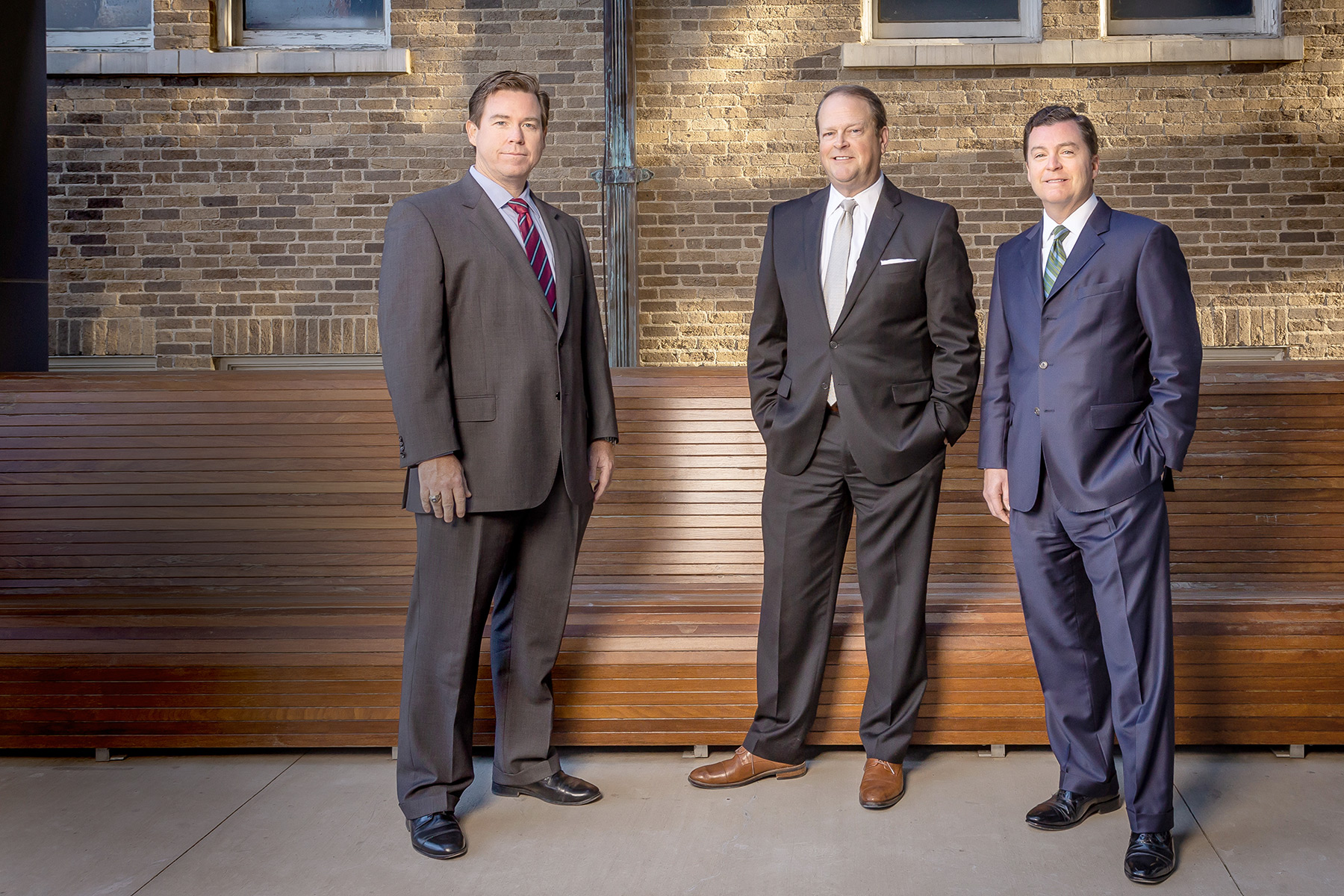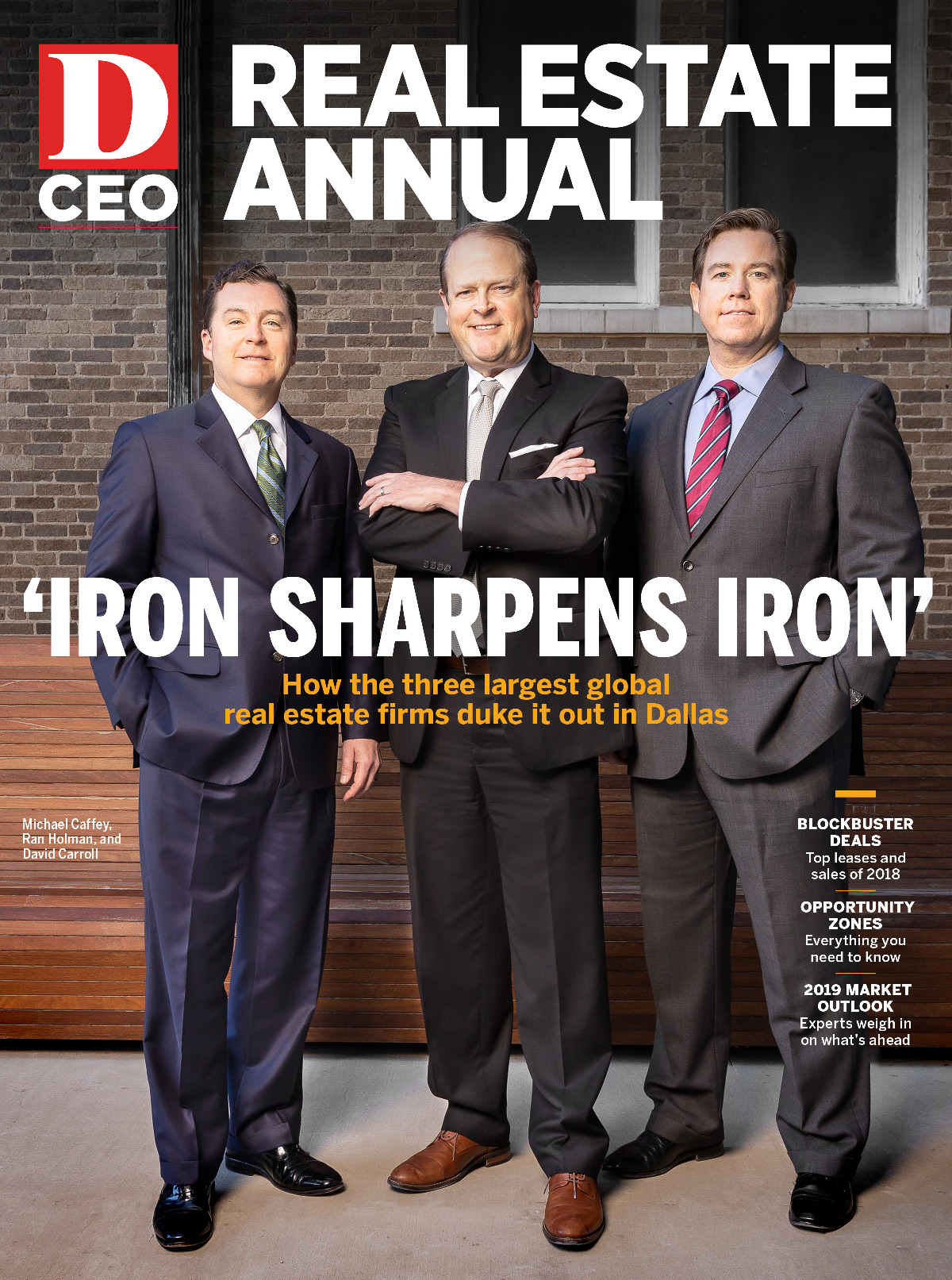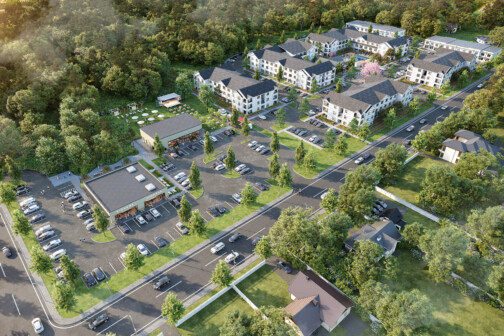Dallas has long been known as a real estate town. Some of the country’s most prolific developers and industry innovators got their start here. And, although they may officially be based elsewhere, the world’s three largest commercial real estate companies have key global executives and significant operations in Dallas. We recently sat down with leaders of these powerhouse firms to talk about the rapidly evolving industry and operating with a spirit of “cooperatition.”
Let’s start with how you got into the business.
Michael Caffey: When I moved to Dallas in 1990 after graduating from the University of Mississippi, I had an awareness that there was a large community of commercial real estate people who seemed to be very active in the community. There was a lot of wealth that had been created. At the same time, a lot of those people had suffered through the downturn. But there was still this very positive attitude about growing and building things. And that still exists today in our community. It’s the backbone of the Dallas-Fort Worth area. Commercial real estate is a big part of that. And that was very appealing.
I got into commercial real estate in 1994 with Grubb & Ellis. I spent two years with the retail leasing group then left to become an office leasing broker at a boutique firm that ultimately became part of Jones Lang LaSalle. For about 10 years, I did transaction work all over the U.S. and throughout Mexico and South America. From there I joined the Trammell Crow Co., in what was then known as global corporate solutions. After CBRE acquired Trammell Crow, I oversaw what was then the tenant rep group and shortly thereafter took over the market leader position, which I still have today. From a domestic standpoint, I lead Texas, Oklahoma, Louisiana, and Arkansas. From an international standpoint, I oversee all of Latin America.
“The ability to have agile space, which allows employees to work in any number of different environments at any given point of the day, is absolutely where we are going.”
Michael Caffey, CBRE
David Carroll: I got into real estate in 1998. I went to the Air Force Academy and served for five years, then finished grad school and was recruited by what at the time was LaSalle Partners. I started out in property management; my first job was working as an assistant property manager of an office building in Las Colinas. In the 20 years since, there has been a lot of change—for all of us. We were thought of as a Chicago company for a long time. Merging with The Staubach Co., 11 years ago now, really established our Texas roots. Dallas has a can-do attitude. It’s a belief that, ‘We can do anything.’ People here have a lot of pride in our city. And that pride is infectious. So, I started in property management and eventually ran the service line for Texas and Louisiana. When we merged with The Staubach Co., I became the chief operating officer of the region. It includes Dallas-Fort Worth, Austin, San Antonio, a couple of offices in Oklahoma, as well as Kansas and New Mexico.
Holman: I got into the business after getting out of school in 1986, going to work for what was then Coldwell Banker Commercial, now CBRE. I initially worked in what we called a data bank, then moved into brokerage. At that time you could still lease buildings and do tenant rep, so I did a little bit of both. My father was a developer and I grew up around real estate folks, and there was just a vigor about the industry. I never considered doing anything else. I always wanted to be a developer. When I got into the business it was like the fireman running into a burning building while everyone was running out. The Tax Reform Act, the savings and loan crisis—our market was in disarray. It’s completely antithetical to what it is now. Right now Dallas is a jewel, as is Texas in general. But back then, we had overbuilt the market so significantly, the local paper said we had a 30-year supply of office space. From CB, I went to work for Vantage, then joined Bill Cawley, chasing development and brokerage. Then CBRE recruited me to be the Dallas leader, which I did from the mid-1990s to right around 2000. It was a much smaller enterprise; the job I had was a fraction of what Mike is doing now, but still a great honor to work for a great firm. But then the development piece still haunted me, so I went to work for Opus & Hines, and then the opportunity with Cushman & Wakefield, once the new platform had been put together with Cassidy Turley. The opportunity to be a part of the new culture and joining these guys on the global platform was just too exciting.
You’re the big three. what does that mean in terms of competition, locally?
Holman: There’s an incredible amount of talent in this town. CBRE and JLL are legacies of titans in the industry—Trammell Crow and Roger Staubach. It’s remarkably competitive here. But what we all love about it is iron sharpens iron. We are all better for the competition, and the ultimate winners are our clients. We have to be better. We have to push the envelope. To compete with these guys, we have to be on our game, all the time.
Carroll: We have a lot of great boutiques in Dallas, but being part of a big platform allows you to be very entrepreneurial, too. You can get done what you need to get done for clients. The big platforms are not slower to move; they can bring more to bear for clients.
Holman: We used to be in the deal business; we used to transact. And now we are far and away in the service business. We have to find solutions that are compelling for our clients. We like to say, ‘One size fits one.’ The ability to take all the tools and tailor something that’s relevant to our clients—that’s the business we’re in now. It’s just a different game.
Caffey: Clients are asking us to advise them on a multitude of different things. The advisory part is the value-added part of any of the transaction-oriented businesses. We look at numerous things, ranging from the cost of labor to the cost associated with moving products from manufacturing facilities all the way to the consumer. The list goes on and on, and it will continue to evolve in the future. We are investing to try to put ourselves in as position where we can harness data that allows us to turn around and provide solutions in a very efficient manner, that drives a high level of value back to our clients. That is the future of this business.
Carroll: The real estate transaction is the last step in that whole consulting process. It’s about labor—how do we recruit and retain the best people, how do we operate within our space. Clients expect us to help create solutions for their businesses. Real estate is a fraction of the cost of labor. It’s a human capital question now, more than it has ever been. And there is that expectation of leveraging technology and data to help clients make decisions. The business is completely different from what it was 10 years ago or even five years ago.
Holman: It drives specialization. We have 30 different practice groups that focus on various parts of the business. To be able to harness that intellect, irrespective of geography, and make it relevant locally, is really important. To help clients figure out how to configure and use the space, we need to understand their businesses in a way that facilitates a great deal not just when they move in, but throughout their occupancy. As real estate companies, we have to live that, too. It all comes down to talent, and our offices and the amenities around them are incredibly important.
You mentioned making investments in technology. Can you expand upon that?
Caffey: One of the things Ran alluded to is this whole notion of scale. Given that we are dealing with customers of scale in today’s world, both on the investor side and the occupier side, we have to be able to drive solutions to customers across geographies and different lines of businesses. To do that requires an investment in all of the tools that allow you to deliver a high level of services. We are investing a large portion of our treasury into technology today, into the ability to harness big data sets and rationalize that into what can we do for clients. I think technology will pay a larger and larger role inside of real estate today, and the scale of our organizations, collectively, will allow us to make investments in that.
Holman: The real estate business used to be almost all art. Now, it’s almost equal portions of art and science. We can’t plan on hunches any more. We have to support it with great data and the technology piece that supports it is more important than ever.
Carroll: We will always be a relationship business, but it has evolved far beyond that. People talk about us being in the fourth industrial revolution, with artificial intelligence and the Internet of Things, sensor technology, and our connectivity and how we communicate. The challenge for all of us is harnessing that. It’s not just our industry, it’s every industry. So, we are constantly looking at it and reinvesting in technology and determining how we can use information in a way that is powerful for clients. It’s a challenge keeping up. It’s moving so quickly right now. And if you ignore it or decide to figure it out later, you’re just going to be left behind.
Holman: What’s fascinating is, with all of this technology, the human element is still central. If computers could be providing these services, they’d already be doing it.
Caffey: Machines will never replace what the human element offers. Humans will continue to relationship with humans, but mechanizing the data and taking it and driving more efficiency into the way we are looking at analysis and humans communicating what that is with each other—that’s the constant.
Carroll: Things used to be based on hunches. Now you can actually see how many butts are in seats for how many hours a day, how many people are coming and going, and you can make adjustments. Look at unemployment in Texas; it’s a battle for talent. It comes down to that work experience. How are my employees going to feel about this space? Is it welcoming? Is it a place that encourages teaming and collaboration? The old offices and traditional setups have gone by the wayside.
Caffey: The ability to have agile space, which allows employees to work in any number of environments that they need, at any given point of the day, is absolutely where we are going. It’s the ability to build a physical work environment that allows workers to have quiet space or focus space or collaborative space, and certainly meeting space. The future is all about working with employees to make sure that the experiences they have while at work go outside of even the work environment. How do we help facilitate workers to procure lifestyle things, like apps to have their dry-cleaning done or buying tickets to entertainment experiences.
Carroll: Who would have thought five years ago that you’d have this concept of activating the tenant experience, where you walk into a building, and all of a sudden things are being pushed to your phone, whether it’s a discount or something else within the amenity base.
Caffey: It’s not a fad; it’s here to stay. It’s the way people are working and the way they will continue to work in the future.
Holman: And it’s not enough to just have the tools. It’s like an orchestra; it’s figuring out how to get the tools to play together in a way that delivers a great experience. That’s the challenge. We all work very hard to connect the dots. If our folks don’t know the tools are there or how to get them and use them, there’s no point.
“Who would have thought, even a few years ago, that real estate firms would be launching technology funds? We’re evolving into technology companies that do real estate.”
David Carroll, JLL
Caffey: All of these things that are being built; they have to be adopted to see the return on what we’re investing in. The adoption of tools and technology is absolutely critical. Sometimes the most highly tenured employees are the most reluctant to change.
Holman: You have to pair them up with someone who’s younger; the whole mentor-mentee relationship becomes something new.
Carroll: It’s not just being aware of the expertise we have in Dallas, it’s national expertise and global expertise. You may not need it every day, but you need to be aware that it exists, so you can go pull it in when you need it … Just think about the first step we’ve gone through, of just harnessing the knowledge and information our organizations already had. It used to be that someone would have some comps over here on this computer, and information would be in the finance group. And those systems didn’t talk to each other. Now, we’re moving toward the great data lake, where all of this information flows in together and you can collectively harness it.
Holman: It used to sit in drawers.
Carroll: Right. And not be shared.
Holman: Exactly. And the shelf life today is nonexistent. It moves so fast and needs to perpetually be updated. It’s actionable data that we’re trying to purvey. Our job is to distill it and use it to help clients make decisions.
Carroll: Clients are no longer looking for a monthly report; they’re looking for real-time data.
All of your companies are publicly traded. how does this affect the competitive landscape?
Carroll: It gives us the resources to go much deeper. As we talk to other, smaller firms, their big challenge is keeping up. They see where the industry is going, and it’s technology and it’s data. At the end of the day, you have to have the resources to invest to leverage that. You look at consolidation in the industry, and some of that is being driven by the realization that the game is changing, and a need to be part of a platform that can bring technology to bear.
Caffey: It’s a very capital-intensive business to continue to operate at scale. As a publicly traded company there is certainly an advantage there. It also helps you understand your public-company clients. You get what their needs are, and the level of transparency at which you need to operate.
What do you love most about what you do?
Carroll: We are in the people business. We don’t make widgets. So, you have to love people and get out there and every day support them so they can give their best. They will tell you, ‘We don’t need managers; we need leaders.’ People need to know that you care about them and that you’re willing to do anything for them.
Caffey: Absolutely. Also rewarding is the fact that every day is a new challenge. It’s a very dynamic business that requires you to deal with a multitude of different business needs. The ability to do things to support your employees, to support clients, to make sure that we’re driving wonderful outcomes on their behalf, the ability to grow your enterprise in a multitude of different ways … is a lot of fun.
Carroll: There is no such thing as a typical day.
Holman: I tell my kids, ‘If you know where you are going, every step takes you closer to it or away from it.’ As we look at who we are and who we aspire to be, it’s not enough to just bring in ability. Obviously we want impeccable character, great ability, and we want will. We want people who are motivated to do their best and deliver the best services. If you can get unified around an ideal, you can do some great things. These gentlemen and their firms are formidable competition for us, and we have to be on our game. We’re up for the fight. These guys are up for the fight. We all make each other better.
Carroll: If you look at this industry, it’s fiercely competitive, but also very collegial. We’re all friends outside of the business.
Holman: My wife is in sales in another industry. She laughs at how we all get together and have lunch or drinks or whatever. She’ll say, ‘I would never do that with my competition.’ And I tell her, ‘But I love these guys.’”
Caffey: That’s a great point. I’m not sure if it’s unique to our industry or not, but it does exist within real estate. In a prior life I worked with David, and in a prior life I worked with Ran. We participate in civic and philanthropic endeavors together, and we’re in the community in social ways together. It is incredibly competitive, but it is very collegial, too, as David said.
Well, You all do business with each other. someone once described it as ‘cooperatition.’
Caffey: It is a constant touch point. So, you need to make sure you maintain good business relationships with each other.
Carroll: Look at the professionalism in the industry. You have to have confidence in the person sitting across the table from you … that they’re an expert, a professional who can get this done with you. You’re putting a lot of time and effort into every one of these projects and transactions. We have different business cards and different logos, but at the end of the day, we’ve got to both be committed to doing the right thing.
Holman: It’s like playing basketball with a buddy. You want to crush him on the court, but then you go out for a beer together afterward.
What is most challenging about what you do?
Holman: Our clients need to know that they are incredibly important to us, and so do our people. That means being available. All of us get pulled in a lot of different directions. Balancing the work demands of the job with the human element of the job is a challenge. We all play leadership roles in the community as well. It pulls us in a lot of directions. I rely on various leaders in my office to tell me where potential blindspots may be developing. Often, the problems we have to troubleshoot—if you can catch them earlier, they’re much easier to process and solve.
Caffey: I agree with Ran. And on a macro level, it’s managing the pace and volume. It does not turn off. You’re on call on the time. This economic cycle we’ve been in now, for more than eight years, has been nothing short of fantastic. But it’s continual. Taking care of yourself, so you can take care of others, is absolutely essential.
Carroll: We all have to have that servant mindset. You’re serving your clients, you’re serving your teams, and you’re serving your community. Everyone needs to understand that you are there to help. That’s your job, and it really means something. There’s not a finish line on any of this stuff. You’re always constantly asking, “What could we be doing any differently? Where are we not hitting on all cylinders?”
Holman: That’s a fantastic point. The game is evolving so much, and it creates a complexity that is sometimes quite challenging.
What role do your Dallas-Fort Worth operations play within your firms?
Caffey: We have our local market area, which are all of the local businesses that support customers in this geographic region. We also have our principal-based businesses, including the Trammell Crow Co. and CBRE Global Investors. A significant part of our shared services organization serving the Americas is located here. Lastly, a fair number of our global corporate leaders operate out of Dallas.
Carroll: We are in a similar situation. We have almost every service line represented in Dallas, and we have local leadership for the region but also national leadership. Dallas-Fort Worth is a big, important, strong market for us. You look at where the future is, and Dallas, with its ongoing growth, will continue to be one of the primary markets where we will invest.
“It’s like playing basketball with a buddy. You want to crush him on the court, but then you go out for a beer together afterward.”
Ran Holman, Cushman & Wakefield
Holman: Same story here. We are represented in all the major food groups, in terms of service lines, here in Dallas, multifamily notwithstanding, and we’re solving for that. Our chief operations officer for the Americas is in the Dallas office. For the reasons that David just mentioned, Dallas-Fort Worth and Texas in general are incredibly important to our firm. The population growth we’re seeing spawns activity in all sectors. This market is vastly important for our firms.
what are your thoughts on not winning amazon?
Carroll: Any time there is an opportunity like this, Dallas does a great job of learning from missed opportunities. What was it that didn’t get us across the finish line? Look at what happened after we missed out on Boeing. Every time we have had one of these opportunities, the region has done a great job of asking what we were missing. And we’ll get that same value out of Amazon.
Holman: Amazon would have gobbled up a bunch of labor. And the fact is, it was 50,000 jobs. Dallas-Fort Worth has grown by over 100,000 jobs for the past eight years. From an incentives standpoint, Amazon was going to get its pound of flesh. Now Texas has more dry powder for other relocations, that may not be as costly on a per-job basis. If there is a silver lining, that’s it.
What are you going keep an eye on in 2019?
Carroll: We’ve been running so fast for so many years. I think we’re all confident that when we see a downturn, it’s going to be a gradual deceleration. We won’t be falling off a cliff. We’re in the best business market in the country. Any time there is a slow down, we’ll be one of the last markets to go in and always be one of the first markets to come out.
Caffey: I think you have to add interest rates to that, too, and what affect rising interest rates may have on tempering growth. But the prospects for all of us who live in and operate in the region are very bright.
Carroll: Just look at the optimism here. We’re all proud to be Texans and have that can-do attitude. We have so many things going for us here. Any time a challenge comes up we figure it out and move forward. You love to be part of a city that has that mindset.
Holman: Dallas is an area of great affluence and accomplishment. But it’s also another city. If you look at the southern sector of Dallas, there’s fantastic opportunity for growth. As the traffic patterns here continue to evolve, southern Dallas is going to be a more important alternative. There are a lot of initiatives within our industry that we’re all involved in that are aimed at improving the southern sector. But as long as California and Illinois and other states keep doing what they’re doing, we’ll continue to see great opportunities.
Caffey: It’s the land of plenty.
Get the D CEO Real Estate Newsletter
Author







